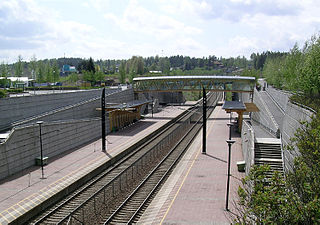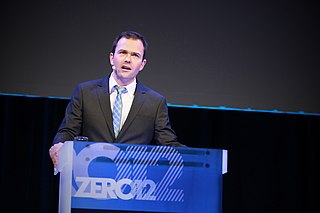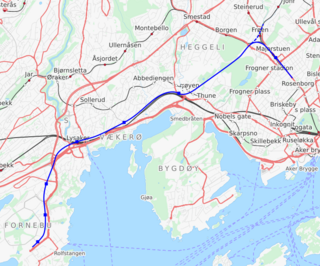Related Research Articles
A hydrogen vehicle is a vehicle that uses hydrogen fuel for motive power. Hydrogen vehicles include hydrogen-fueled space rockets, as well as ships and aircraft. Power is generated by converting the chemical energy of hydrogen to mechanical energy, either by reacting hydrogen with oxygen in a fuel cell to power electric motors or, less commonly, by burning hydrogen in an internal combustion engine.

Sandefjord Airport, Torp is an international airport located 4 nautical miles northeast of Sandefjord, Norway and 110 kilometers (68 mi) south of Oslo. The airport features a 2,989-meter (9,806 ft) runway aligned 18/36. Torp partially serves as a regional airport for Vestfold and in part as a low-cost airport for Eastern Norway and the capital, Oslo. Widerøe have a base at Torp, serving both domestic and shorter International flights. It also sees scheduled flights by Ryanair, Wizzair, Norwegian and KLM Cityhopper. As of 2021, it is the second-largest airport in eastern Norway in terms of flights after Rygge shut down in 2016.

A hydrogen station is a storage or filling station for Hydrogen. The hydrogen is dispensed by weight. There are two filling pressures in common use. H70 or 700 bar, and the older standard H35 or 350 bar. As of 2021 around 550 filling stations were available worldwide.

The Vestfold Line is a 137.79-kilometer (85.62 mi) railway line which runs between Drammen and Eidanger in Norway. The line connects to the Drammen Line at the northern terminus at Drammen Station and continues as the Bratsberg Line past Skien Station. The line is exclusively used for passenger trains, which are provided by the Norwegian State Railways, which connect northwards to Oslo and south-westwards to Grenland. The 13-kilometer (8.1 mi) section from Eidanger to Skien is often colloquially included in the Vestfold Line.The standard gauge line is electrified at 15 kV 16.7 Hz AC and has twelve remaining stations. The Vestfold Line runs through the coastal region of Vestfold and serves major towns including Holmestrand, Tønsberg, Sandefjord and Larvik, as well as Sandefjord Airport, Torp.

Oslo Central Station is the main railway station in Oslo, and the largest railway station within the entire Norwegian railway system. It connects with Jernbanetorget station. It's the terminus of Drammen Line, Gardermoen Line, Gjøvik Line, Hoved Line, Østfold Line and Follo Line. It serves express, regional and local rail services by four companies. The railway station is operated by Bane NOR while its real estate subsidiary, Bane NOR Eiendom owns the station, and was opened in 1980.

The Gardermoen Line is a high-speed railway line between Oslo and Eidsvoll, Norway, running past Lillestrøm and Oslo Airport, Gardermoen. The line is 64 kilometres (40 mi) long and replaced the older Hoved Line as the main line north-east of Oslo. The older Hoved Line now handles commuter and freight traffic, while the Gardermoen Line handles high-speed passenger trains and freight trains laden with jet fuel for the airport. Both lines are owned by Bane NOR.

The Trunk Line is a railway line in Norway which runs between Oslo and Eidsvoll. The line is owned by Bane NOR.
Hydrogen technologies are technologies that relate to the production and use of hydrogen as a part hydrogen economy. Hydrogen technologies are applicable for many uses.
Opened on the 8th of October 1998, the only high-speed rail in Norway, on the railways of Norway is on Gardermobanen, a 64 kilometer line between Oslo Central Station and Eidsvoll via Oslo Airport. The main service on this route is Flytoget, commuting between Oslo Airport and the metropolitan areas of Oslo at speeds of up to 210 km/h (130 mph). It was extended westwards to include the city of Drammen in 2008, though not at high speed. The high-speed section is also used by express and regional trains between Oslo and Eidsvoll.

Zero Emission Resource Organisation or ZERO is a Norwegian environmental organisation that was founded in 2002 to work on the reduction of greenhouse gases, primarily in Norway. The philosophy of the organisation is that if new facilities are made emission-free, then when existing plants and methods are phased out due to old age, society is left with emission-free facilities. The primary working areas include CO2 disposal, renewable energy, especially wind power, and new transportation fuels, including hydrogen and biofuel. ZERO is organised as foundation and was started by former activists and employees of Natur og Ungdom and Bellona. Funding sources include industrial associations and companies. ZERO is led by Marius Holm (director) and Erik Espeset (chairman).

Oslo Airport Station, also known as Gardermoen Station, is a railway station located in the airport terminal building of Oslo Airport, Gardermoen in Norway. Located on the Gardermoen Line, it is served by the Airport Express Trains, express trains to Trondheim and Oslo, regional trains to Lillehammer and Skien and commuter trains to Eidsvoll and Kongsberg.
A hydrogen infrastructure is the infrastructure of hydrogen pipeline transport, points of hydrogen production and hydrogen stations for distribution as well as the sale of hydrogen fuel, and thus a crucial prerequisite before a successful commercialization of automotive fuel cell technology.

The Hydrogen link network in Denmark was established in 2005 by the Nordic Transportpolitical Network to form a hydrogen highway with hydrogen Sweden and hynor as part of the Scandinavian hydrogen highway partnership.

HCNG or H2CNG is a mixture of compressed natural gas and 4–9 percent hydrogen by energy. It may be used as a fuel gas for internal combustion engines and home appliances.
Hydrogen purity or hydrogen quality describes the presence of impurities in hydrogen when used as a fuel gas. Impurities in hydrogen can interfere with the proper functioning of equipment that stores, distributes, or uses hydrogen fuel.
An HCNG dispenser is a type of fuel dispenser at a filling station that is used to pump HCNG into vehicles.

ITM Power plc is an energy storage and clean fuel company founded in the UK in 2001. It designs, manufactures, and integrates electrolysers based on proton exchange membrane (PEM) technology to produce green hydrogen using renewable electricity and tap water. Hydrogen produced via electrolysis is used for mobility, Power-to-X, and industry.

The Fornebu Line is an under construction rail line which will serve the peninsula of Fornebu in Bærum, Norway. The line is under construction and the transit agency Ruter is working towards connecting it to the Oslo Metro. The line has at various stages been proposed as an automated people mover, tram-train, tramway, light rail, stadtbahn, rapid transit, bus rapid transit and commuter rail, with the rapid transit option being selected as the final proposal. The metro line will start at Majorstuen Station and will run entirely in a tunnel for 8,150 meters (26,740 ft). The line will have six stations, at Skøyen, Vækerø, Lysaker, Telenor Arena, Flytårnet and Fornebu Senter. A depot will be built at Fornebu and the line will connect to the metro's Common Tunnel at Majorstuen.

Nel ASA is a Norwegian company founded in 1927 and based in Oslo. Nel is a global company providing solutions for the production, storage and distribution of hydrogen from renewable energy sources. Nel is listed in the OBX Index of the Oslo Stock Exchange. As of March 2020, the largest shareholder is Clearstream Banking S.A. with a stake of 44.81%.

The Grenland Line is a proposed high-speed railway line that would connect Grenland and Gjerstad in Norway. Specifically, the line would connect the Sørlandet Line at Skorstøl to the Vestfold Line at either Porsgrunn or Skien, allowing passenger trains from Stavanger and Kristiansand to be routed on the Vestfold Line through Grenland and Vestfold. The Grenland Line is proposed built with double track and with a speed of 250 km/h (160 mph). Three routes have been proposed, varying in length between 64 and 70 kilometers. A prerequisite is that the Vestfold Line be upgraded to double track and high-speed, a process that started in the mid-1990s and which is scheduled for completion in 2032. A completion of the upgraded Vestfold Line and the Grenland Line would reduce travel time for passenger trains between Gjerstad and Oslo by about 70 minutes.
References
Notes
- ↑ Supported by the Norwegian governmental funding agency, Transnova (http://www.transnova.no)
- ↑ "Hydrogenframtida i fare".
- ↑ HYOP
- ↑ BioZeg [ permanent dead link ]
- ↑ Dalløkken, Per Erlien (2 January 2017). "Bruker 39 millioner kroner slik at hydrogenbussene kan kjøre tre år til". Tu.no (in Norwegian). Retrieved 31 December 2020.
- ↑ "IFE Hynor Hydrogen Technology Center (IFE Hynor)". IFE. Retrieved 31 December 2020.
- ↑ http://www.mynewsdesk.com/no/oslo-lufthavn-as/news/oslo-lufthavn-faar-hydrogenstasjon-121152 [ dead link ]
- ↑ "HyNor Lillestrøm" (PDF). Archived from the original (PDF) on 10 June 2015. Retrieved 21 November 2013.
- ↑ Innovation Zone of the Hynor Lillestrøm Hydrogen Station Now Open